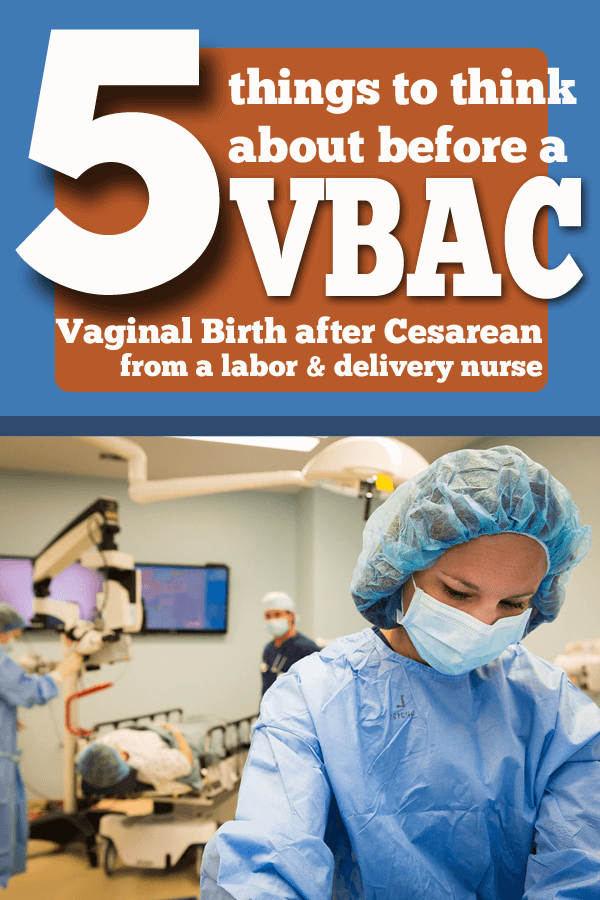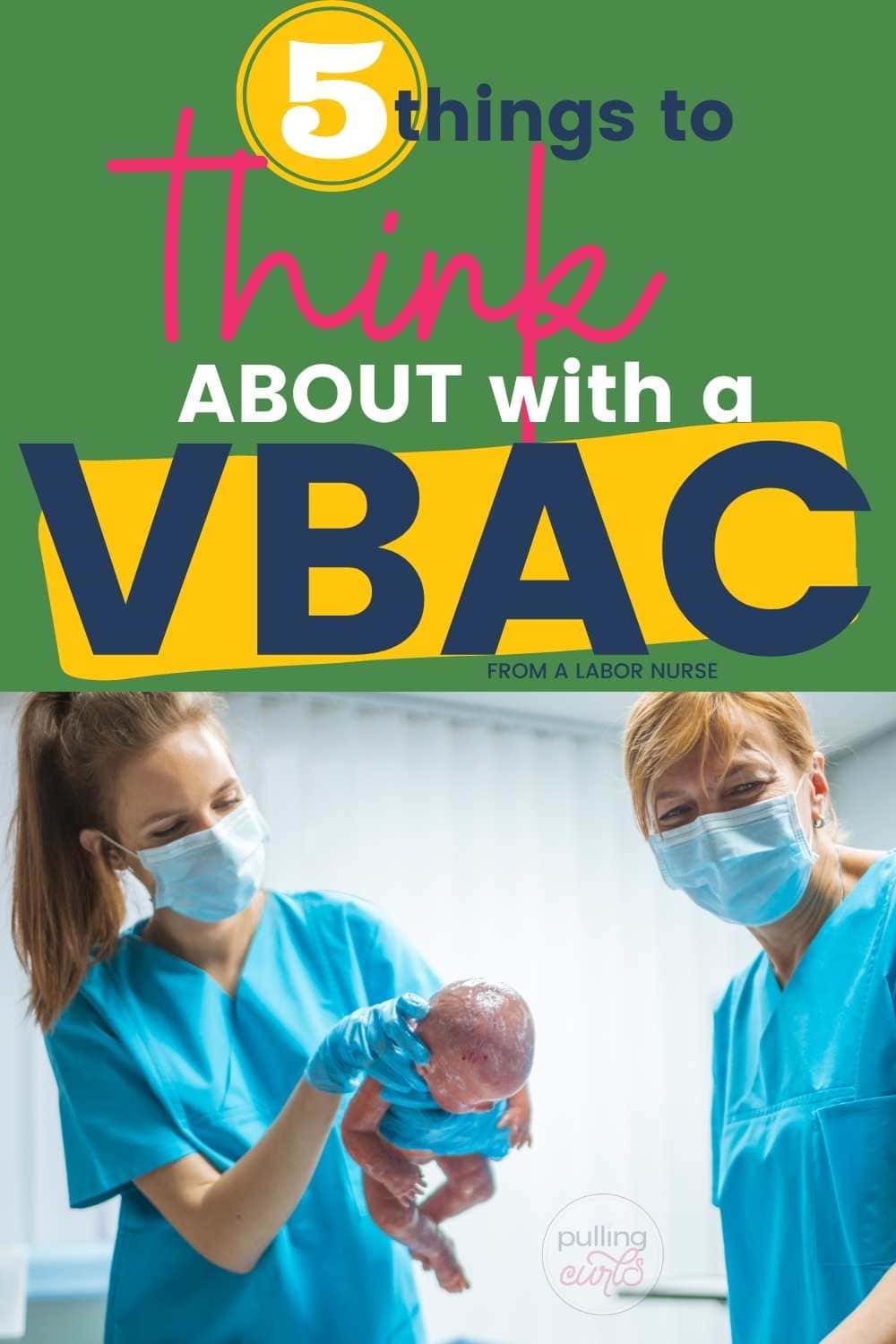First off, they’re actually called TOLAC (Trial Of Labor After Cesarean). But, no one wants to be a Toe-lac. They’d rather be a VBAC (a VBAC would actually be a successful vaginal birth after cesarean section). There, feel educated?

First off, hello! I’m Hilary — many people know me as The Pregnancy Nurse 👩⚕️. I have been a nurse since 1997 and I have 20 years of OB nursing experience, I am also the curly head behind this website Pulling Curls and The Online Prenatal Class for Couples. 🩺 I’ve helped with many TOLACs and I always feel SO triumphant when we get a VBAC, so I would love to share with your some tips about getting it done:
VBAC rates are always on a pendulum. I’m not sure how much of that pendulum is associated with malpractice insurance, as that is where a lot of anything comes from in this business. When I first started (13 years ago), NO ONE VBAC’d, and then we went to where most OBs were trying it, and now I feel like we’re swinging back the other way. Here are my 5 thoughts on VBACs.
1. Ask your doctor about their VBAC rate. Some just don’t do them. Ever. And that’s their choice. You have to realize that once a person (because doctors are PEOPLE) has a bad experience with something, they are unlikely to do it again. Labor and delivery can be a happy place, but VBAC gone wrong can make it a very sad place.
2. Your doctor, most likely, will have to be on the hospital campus if you are in labor as a VBAC. Our doctors and their offices are on our hospital campus, so that works well during the day. Basically, they need to be there within minutes if something happens.
3. The main concern with VBAC’ing is uterine rupture. That means, your uterus will start to pull apart your old incision. Your uterus thins considerably during pregnancy (as it is stretched out). That is totally normal. You might have heard of people who have a “window” — that means the uterus is so thin, it goes translucent in areas and you can see the baby. I have also heard of windows on patients who haven’t had c-sections, so take that for what it’s worth.
I also have a whole post on cesarean section scar pain during pregnancy.
BTW, want to know more about the important parts of pregnancy like this, be sure to check out this class!
4. You might want to consider an early epidural. A few of our anesthesiologists push hard to have an in-dwelling epidural catheter once you’re in labor. That way, if you have to have emergency surgery, you won’t need general anesthesia. General is no fun.
5. Go with what your doctor says. If your doctor has a few patients that they HAVE done VBACs on, consider their opinion. Why did your first one happen? Was it twins, or breech? In that case, you don’t have a tested pelvic vault. You might want to consider it. If you didn’t dilate or the baby didn’t descend, it is likely to not happen again. SO, ask your doctor (none of these things I have said here should take the place of asking your doctor — they know you and your health history).
Btw, if you’ve had a breech baby before, you might wonder when they turn head down. I also have a post on symptoms of baby turning head down.
FIND. A DOCTOR. YOU. CAN TRUST. The end.
Anyway, those are my thoughts about VBACs, (or TOLACs). I must say whenever I have one, I feel like a warrior who’s just won a pretty significant prize. I’m pro-vagina. 🙂 My friend Katelyn has a great post about successful VBAC — and she should know, she’s had 2 of them!
BTW, I love this episode I did with a chiropractor that you might find helpful:
If you’re interested in more information you can use for your pregnancy, and more tips to communicate with your provider check on the Online Prenatal Class for Couples. It can be done together in just a few hours.
Not sure we’re a good fit check out my free class — It’s your first step towards being your own birth boss.









Elizabeth says
Ummm… where’s the “benefits” part? Where’s the part about the risks of a second (or third or more) cesarean? Where’s the part about how not all ruptures are the same, and the risk is VERY low (less than 1% for any rupture and less than 0.3% for a catastrophic rupture)? Where’s the part about early epidurals (in fact, epidurals at all) increasing the risk of a cesarean?
And the doctor may have to be nearby. So what? Isn’t that what they’re paid for. My doctor (and anybody who’s attending the birth of my child, including L&D nurses) has been hired to provide a paid service. Just like I would expect my mechanic to be there while my oil’s being changed, I expect the staff to do be there.
Better yet, get a midwife- either a DEM/CPM for a homebirth (yes, HBAC is a safe option for many women) or a CNM for a hospital birth, and you probably won’t have to deal with the crazy fear-mongering that brings about most of the primary cesareans (and unnecessary repeat cesareans) in the first place.
Hilary says
I guess I could have been more clear that the benefit is a vaginal delivery. Less risk to you and the baby. I would guess most people are already clear on the benefit to a VBAC.
I agree, you are paying the doctor — but some are NOT willing to stay around.
BUT, I need to state CATEGORICALLY that I STRONGLY disagree with having a home TOLAC birth. I would be EXTREMELY skeptical of a lay (or otherwise) midwife who is willing to do one. That is a high risk pregnancy. The end.
I LOVE VBAC’s, but I know they can go very wrong. I wrote this post for a woman considering a VBAC {or a tolac} — not anyone considering a home birth or mad that they had a c-section the first time.
Healthy mom. Healthy baby.
Christina says
I agree- there are many risks with repeat c-sections. It has been proven that a baby is less likely to have breathing problems if a mother labours for any amount of time before a c-section. I believe that trying for a vbac is always the best option; even if it ends in a repeat c-section.
Having an epidural is not ideal when having a vbac because an epidural brings additional risks and possible complications. It’s sad that some professionals push for this.
Well trained registered certified midwifes are the best option for when wanting a vbac. Where I live in Canada midwives are paid for and monitored by the government. It is highly regulated and safe.
This article was so disappointing to read- I thought it would be a balanced look at the pros and cons but it was not.
Hilary says
Christina, I am sorry you were disappointed. I love the idea of Canada’s midwives, I wish I practiced with them here but I work with old school doctors who are anti-midwife. {sigh}
BUT, it’s unfair to say that every woman should try a V-bac. That’s why medical professionals get to make that call. I’m sure even they wouldn’t say every woman should VBAC. but, I love it when a VBAC is sucessful! 🙂
Laura @ Little Bits of Granola says
My 2nd baby was a VBAC. I would say the key to success is a great team you trust and feel totally confident about. My doc was super supportive and actually suggested it for me, but was also very clear about the risks. I appreciated her honesty and openness. My L&D nurses were incredible. They understood VBACs well and knew exactly how to answer all of my questions, especially regarding what happens if things go south. Personally, I would be TERRIFIED to try a VBAC at home. My doc knew how to handle a VBAC gone wrong and how to perform a c-section (she did my first) in case that had to be done in an emergency situation. I can’t imagine putting that trust in anyone other than a doctor/surgeon.
Hilary says
Laura, I’m glad it worked out for you. I LOVE a sucessful VBAC!!!! 🙂
katie says
My first son was an emergency c-section because he got stuck and so when I pushed his heart rate dropped. My Dr didn’t know where his nose was so he didn’t want to use forceps so he got another opinion. I was devastated at the fact I needed a c-section but knew I would be in good hands.
When I was pregnant with my second son my dr was done delivering babies so he referred me to his partner in the office which only wanted to do a c-section. I didn’t feel that was right, why not let me try? So after my sister-in-law had her baby I switched drs at 8 months and couldnt have been happier. I had a successful VBAC. I have had 2 more since my c-section and am hoping to have another with this baby in August. I know that if anything goes slightly wrong I will be wheeled into the OR. I know I have to wear a special bracelet notifying everyone that I am trying for a VBAC. I am so grateful to have been able to deliver 3 kids by VBAC.
I always go for an epidural because I can’t stand pain and then also if I have to go into the OR I am already half way numb so it won’t take long to get the rest numb.
I am so grateful for all the nurses and staff and the many hours they put in. Thank you for your hard work and dedication!!!
Hilary says
Katie, I seriously feel so much victory when we have a successful VBAC, i’m glad it worked for you and you found a doctor that MADE it work. They’re the best!
Kayla H says
I really appreciated the tone of this blog post. While some may feel that you are speaking out against VBAC’s, I felt that you were very neutral. I chose to have two repeat c-sections after my first one was an emergency. I have known people that have had very successful VBACs and then some who were glad that they had a repeat c-section because during the surgery they found out that they had a uterine window. I would say that the most important thing, regarding any method of birth, is to find a team of people that you trust and inform yourself of the risks of every possible situation. I worked for my doctor before I used him as my own doctor, and I knew that he would do everything in his power to keep me safe. The ultimate goal is healthy mom, healthy baby, regardless of the method you choose to get them here or feed them, etc. The judgmental tone that many of these types of posts can bring (yours does not) really saddens me. This one is very refreshing :). Thank you!
Hilary says
Awh, I’m so glad you liked it. Thanks for commenting!
Jenn says
I don’t agree with a majority of what is said here. If you are a vbac, it’s important that you are able to FEEL what’s going on to be able to communicate to your doctor or midwife. That being said, an early epidural let alone an epidural at any point is going to mask the pain that comes with a uterine rupture.
With our rates at nearly 40-50% cesarean sections, it’s most likely the woman did not need one the first time around and I see no problem with a hbac, dependent on other factors. Being vbac alone does not make one high risk.
And never, never, ever should a woman make a decision based on the convenience of their doctor or midwife. If the doctor cannot be ‘available’ for the vbac… Well, then, maybe it’s time to choose a different provider.
We are living in a time where an anesthesiologist can get a port in within minutes. I think the fear of general is not based on current information.
Hilary says
Jen, I think you’re not well versed in your labor knowledge. Your last paragraph doesn’t make a lot of sense. So, someone’s uterus is RUPTURING and we take the time to do a spinal? Also, they say that rupture pain can most often be felt through an epidural. C-section rates around the US remain at 33%. Doctors vary, that is true. But that’s the national average.
Jenn says
Hep lock? And yes, national average is 33%, however, I’m located in an area where we are upwards of 40-50%. Even at 33%, we are talking 1 in 3 women. Have you had a vbac personally? Or are you just talking as a L&D nurse?
Women who choose to vbac choose it because it’s a safer choice than a repeat c section. Your blog makes it sound dangerous and unattainable.
I’ve had a vbac, hbac, and because of that, and the fact that many women do not know their choices when it comes to hospital births, I strive daily to get information to them. I’m a childbirth educator and I take my position very seriously.
Hilary says
I’m not sure what you’re talking about. I also disagree that my blog makes it sound unattainable. BUT the reality is that with SOME doctors it truly IS unattainable. I would say that the 5 years I went to college, he 15 years I’ve been a labor and delivery nurse along with the numerous certifications I’ve had as well as seeing women on death’s doorstep from various things that have gone wrong during their delivery mean that I probably also take my position very seriously.
Jennifer says
I have had two VBACS (initial C-section was for breech presentation) and everything you said in this article was exactly what I was told by the doctor. He was great, said he had maybe only had one V-bac all year b/c no one ever requests them, but was open to it. I will say the first one was very hard to recover from, maybe harder than my c-section, but the second one was so easy. I am glad doctors will do them and I recommend searing for a doctor who is open to one if you had a c-section for the reasons listed. Thanks for being a great L&D nurse. I don’t know why anyone would want to VBAC at home. The nurses and hospitals that have supported me have been amazing. My third child was not crying upon delivery and while I wasn’t told that anything was wrong, the nurses had him crying and healthy very fast. Thankful for L&D nurses.
Hilary says
Awh, I’m glad you liked the article!
Jacy says
Hello! I am also an RN, though in adult ICU, not OB.
I wanted to clarify: although the term TOLAC is preferred by providers, VBAC is preferred by many women. The reason is not that they don’t know the “proper” term, because I would say that many if not most women trying for a VBAC do know, but that saying TOLAC feels like saying “Oh, well, we’ll try it…” vs VBAC is the goal. For me, I am currently pregnant with my second, and I say I’m “hoping to have a VBAC”. My first was breech, so I haven’t labored much at all, but my view is that there is little reason to think that my body can’t do it. Yes, there is a risk of uterine rupture, but I’m bummed you didn’t state the actual numbers. From my recent research, risk of uterine rupture is 0.2-1.5%. Chances of having any one of several complications of repeat C-sections are at significantly higher rates, as far as I understand.
For my first, I wanted to have a home birth with a CNM. Since I am now no longer low risk, and the national birth center guidelines recommend against VBACs (anywhere without continuous monitoring) I am planning to deliver at a VBAC friendly hospital (best rates in the area) with a VBAC friendly midwife group.
As for the person who commented about HBAC or birth center birth after C/S, there are LPMs who will deliver VBACs at birth centers near me, but no CNMs will. I feel like that should make people question it, but they do them anyway. >_<
Thanks for sharing your views!
Hilary says
I don’t believe in numbers. EVery case is different, and it’s so important to talk about the whole history with your doctor. I will say the MOST important part is finding a doctor who’s on board. I would 100% never, ever recommend someone try to vbac at home. Ever.
Always love hearing from a fellow nurse. 🙂